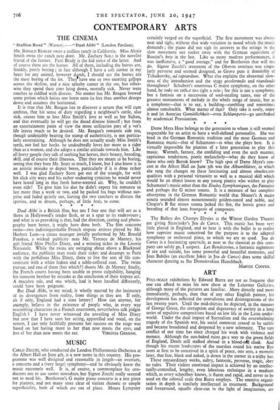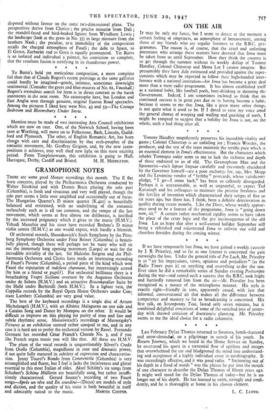ART
FULL-SCALE exhibitions by Edward Burra are not so frequent that one can afford to miss his new show at the Leicester Galleries, although many of the pictures are familiar. More directly and more immediately, perhaps, than that of any other English painter, his development has reflected the convulsions and disintegrations of the last twenty years. Until the mid-thirties he depicted, in the manner of George Grosz, the corruption and degeneracy of society in a long series of repulsive compositions based on low life in the Latin under- world. Under the dual impact of Surrealism and the overwhelming tragedy of the Spanish war, his social comment ceased to be satiric and became broadened and deepened by a new solemnity. The vast conflict of our time has since charged his work with violence and menace. Although the sun-baked ruins gale way to the green fields of England, Death still stalked abroad in a blood-r41 cloak. And though his recent landscapes of the marshes sound his native Rye seem at first to be conceived in a spirit of peace, one sees, a moment later, that fear, black and naked, is down in the corner in a trilby hat.
These extraordinary works, sultry, fantastic, perverse, tragic, obey no rules. Their violent emotional impact is achieved by an intellec- tually-controlled, lengthy, even laborious technique in a medium which, as every sch2olboy knows, is fluent and rapid, and never to be
used on the colossal scale that Burra employs. The emotive organi- sation in depth is similarly intellectual in treatment. Background and foreground, etivally clear-cut in the light of imagination, are
disposed without favour on the same two-dimensional plane. The perspectives derive from Chirico ; the precise minutia from Dali ; the mandril-faced and bird-beaked figures from Wyndham Lewis ; the landscape (look at the grass in No. 33) in large measure from the brothers Nash ; the peculiar, twit immobility of the composition recalls the charged atmosphere of Fuseli ; the debt to Spain, to El Greco, Zurbarin and to Goya is equally pronounced. Yet Burra is so isolated and individual a painter, his conviction so complete, that the resultant fusion is terrifying in its thunderous power.
* * * *
To Burra's bold yet meticulous composition, a more complete foil than that of Claude Rogers's recent paintings at the same galleries could hardly be imagined—gentle, intimate, sometimes downright sentimental. (Consider the greys and blue-mauves of No. 61, Vauxhall.) Rogers's tremulous search for form is in direct contrast to the harsh statements in the next room. No catastrophe here; but London and East Anglia seen through genuine, original Euston Road spectacles. Among the pictures I liked best were Nos. 43 and 53—The Cottage Bedroom and Bloomsbury Under Snow.
* * * * Mention must be made of two interesting Arts Council exhibitions which are now on tour. One, of the Norwich School, having been seen at Worthing, will move on to Folkestone, Bath, Lincoln, Guild- ford and Plymouth. The other, of English Romantic Art, has been chosin with care and discrimination by that arch-prophet of the romantic movement, Mr. Geoffrey Grigson, and, by the new juxta- positions it achieves, may well shed new light on this most exciting period. From Templenewsam, this exhibition is going to Hull,



































 Previous page
Previous page